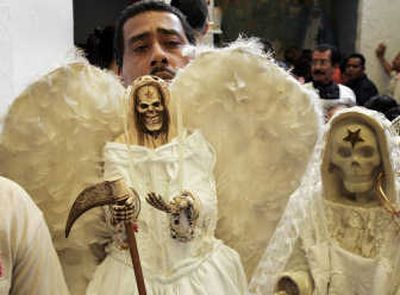Mexican sect unveils new, softer Death Saint

MEXICO CITY – Death just isn’t what it used to be.
A small religious group that worships the grim reaper and is fighting for government recognition unveiled a softer image of their so-called Death Saint on Sunday: a woman with a porcelain face, brown, shoulder-length hair and long thin fingers.
Hundreds of worshippers filed into the Santa Muerte sanctuary in downtown Mexico City to see the statue in a flowing golden dress and veil, clutching a rose.
She offers another option to followers who have traditionally prayed to figures of a skeleton dressed in a black cloak and carrying a scythe, or in a long flowing white gown.
David Romo, the Traditional Mex-USA Church’s archbishop, said the new incarnation of the saint appeared to a woman in a dream in December and told her to ask Romo to commission a statue so devotees could see her new look.
He denied the change is a publicity stunt to win government recognition and shed the group’s image as a cult dabbling in black magic.
“This image is one of justice, of freedom, but above all one that reveals the face of God,” Romo said.
Believers say the Death Saint kills only on God’s orders.
The church, an unofficial offshoot of Roman Catholicism, was registered as a religious group in 2003, allowing it to legally raise money and own property.
But in 2005, the government withdrew its permit after an excommunicated member accused it of forcing followers to worship death and failing to stick to its bylaws. The church started filing papers again last month to gain official status.
The Catholic Church speaks out against worshipping Santa Muerte, linking it to black magic, Satanism and cults.
Romo said Catholic authorities are trying to scare people away from the group, which he said is growing in popularity mostly among Mexicans and Mexican Americans.
Santa Muerte, which some believe to be rooted in pre-Colombian beliefs, is one of several unofficial folk saints worshipped in Mexico.
Death is commonly honored as a part of life in Mexican culture – such as during November’s Day of the Dead celebrations – and does not have the same morbid stigma as in other societies.
Yareli Ceron said worshippers will continue praying to the grim reaper, but now also to the new image which will help the group gain respectability.
“Everyone still loves the skeleton, but now there will be no reason to criticize” the Death Saint, said Ceron, who was among the crowds filing past the new statue.
Standing nearby, Mabel Gonzalez, agreed.
“It’s a lot better,” she said. “She’s not as scary now.”